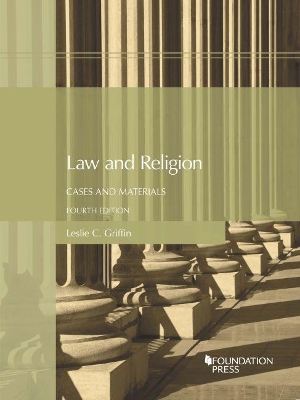
The fourth edition was updated to include important new Supreme Court cases on governmental prayer, reproductive healthcare rights, the Religious Freedom Restoration Act (RFRA), and same-sex marriage. The fourth edition continues the book's interdisciplinary approach to law and religion, its student-friendly notes and questions, and its inclusion of numerous non-Supreme Court cases from a variety of state, federal, and international courts. The chapters were reorganized to highlight the impact of the Court's most recent cases on the subject matter of law and religion. The first six chapters provide the foundational information about free exercise, establishment, and RFRA: 1. Free Exercise of Religion identifies the ever-increasing diversity of American religion versus non-religion. It now includes United States v. Seeger, as a lead conscientious objection case explaining what the Court means by "religion." 2. Introduction to Establishment now includes the Court's decision upholding government-sponsored prayer in Town of Greece v. Galloway, and asks if Galloway will change all future Establishment Clause analysis. 3. What is an Establishment of Religion? examines older establishment precedents about religious symbols and monuments, public funding of religion, and religious speech in light of Galloway. The chapter also focuses on the funding issue the Court will hear in the 2016 Term in Trinity Lutheran Church v. Pauley, which asks if state bans on church funding violate the federal Establishment Clause. 4: Constitutional and Statutory Protection of Free Exercise provides extensive coverage of the ramifications of the Court's RFRA decision, Hobby Lobby, which accommodated for-profit businesses from providing contraceptive benefits to their employees. 5: Conscience, Complicity, and Conscientious Objection relates Hobby Lobby to the Court's order searching a compromise between religious nonprofits and the government in Zubik v. Burwell. This chapter explores military, medical, and legal conscientious objection and analyzes the increasing number of complicity claims faced by courts hearing RFRA cases. It also includes the case of Kim Davis, the Kentucky clerk who refused to issue marriage licenses to same-sex couples. 6: Conflicts between Individual and Institutional Religious Freedom explores the Court's increasing protection of institutional over individual religious freedom by looking at three topics: church property disputes, employment discrimination, and torts. The employment discrimination section now includes an overview of Title VII's religious discrimination provisions and the Court's recent decision interpreting them in EEOC v. Abercrombie and Fitch. The chapter also explores in detail the repercussions of Hosanna-Tabor v. EEOC, the ministerial-exception case that was brand new in the third edition. The first six chapters provided the basics about free exercise, establishment, and RFRA. Later chapters are more specialized and can be assigned at the professor's discretion, depending upon student interest. 7: RLUIPA: The Religious Land Use and Institutionalized Persons Act. RLUIPA now has its own chapter, which focuses on how the RFRA decisions studied in Chapters 4 and 5 will influence interpretation of RFRA's twin sister statute, which applies to institutionalized persons (prisoners) and land use. 8: Comparative Religious Freedom was completely revised. It now includes cases from other countries that parallel the subjects already studied in earlier chapters of the casebook. A section on religious garb, including a Turkish case about hijab bans, recalls Abercrombie. A section on blasphemy connects to the free (religious) speech jurisprudence. Conscience receives extensive treatment because it has become so important in U.S. law. Chapter 8 includes Bayatyan v. Armenia, in which the European Court of Human Rights recognized a religious freedom right to military conscientious objection for a Jehovah's Witness who objected to military service. It also presents a British case similar in reasoning to the Kentucky clerk's case, Miller v. Davis. And it introduces a case that has been described as "Australia's Hobby Lobby." Thus we consider the role of religious exemptions in international law. 9: Religion and Politics now focuses on same-sex marriage instead of stem-cell research, exploring the role that presidents' and justices' religion played in the marriage equality discussion. The majority opinion and dissents from Obergefell v. Hodges are highlighted; all the justices' opinions referred to religion. The tax section was updated to examine the repercussions of Pulpit Freedom Sunday for tax law's restrictions on political activity. 10: Teaching about Religion and Science includes new efforts to add religion classes and remove evolution from public schools. 11: The Old and New Law of Religion still contrasts the Court's treatment of the traditional Amish faith in Yoder with updated information about the Nones' religious identity and political activity.
| ISBN: | 9781634605236 |
| Publication date: | 30th December 2016 |
| Author: | Leslie C Griffin |
| Publisher: | LEG Inc. (dba West Academic Publishing |
| Format: | Paperback |
| Pagination: | 778 pages |
| Series: | University Casebook Series |
| Genres: |
Constitutional and administrative law: general |